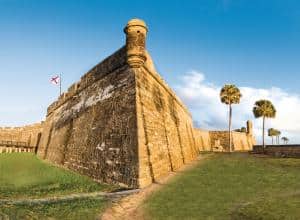Castillo de San Marcos -16th century Spanish fortress built to protect Florida from raiding privateers
Hispanic Heritage Month Continues through October 15!
ST. AUGUSTINE, FLORIDA, US, October 1, 2021 /EINPresswire.com/ — – Hispanic Heritage Month continues through mid-October, and what better way to celebrate than visiting St. Augustine, Florida, the place where Hispanic influence began in the United States.
St. Augustine was founded by Spanish explorer Pedro Menéndez de Avilés in 1565, more than 40 years before the first English settlement was established in Jamestown, Virginia. Today, Hispanic influences live in its streets, attractions, hotels, and restaurants. Here are a few ways to explore the impressive Hispanic Heritage that make a most unique city in North America:
• Castillo de San Marcos – This imposing fortress is the oldest masonry fortification in North America and it took more than 20 years build (1672-1695).
• Ponce de Leon’s Fountain of Youth Archaeological Park – The park is the site of America’s first colony, settled by Spaniards in 1565. Take a drink from the fountain, hear a Spanish Cannon roar and more.
• St. Augustine Historic district and Aviles Street – St. Augustine holds a special place in America’s history as the oldest continuously occupied European settlement in the continental United States. Aviles Street is the oldest street in the United States and is today one of the most interesting places to explore in St. Augustine.
• Fort Matanzas – This fort guarded St. Augustine’s southern river approach. The colonial wars are over, but the monument is still protecting the fort. It was built in 1740.
• Mission Nombre de Dios – On September 8, 1565, Pedro Menéndez de Aviles landed and proclaimed this site for Spain and the church.
On that date, Father Francisco López de Mendoza offered the first Holy Mass and became the first Catholic parish in the nation.
During Hispanic Heritage Month be sure to visit one of the many restaurants that deliver flavors inspired Hispanic influences. Some of the local favorites include:
• Columbia Restaurant – A classic Spanish-style setting with old-world charm and award-winning Spanish/Cuban cuisine and wine.
• Michael’s Restaurant – A casually elegant dining experience with a celebrated chef, dedicated staff, and passion for exquisite flavors and world-class wines.
• Llama Restaurant – The unique flavors and cuisine of Peru are evident with every dish.
• De Leon La Cocina – with two locations serves Latin, Colombian, Spanish, and South American dishes prepared by skilled culinarians
• Spanish Bakery & Café – Nestled under the Historic Cedar Tree, serving traditional freshly-made baked goods, empanadas, picadillos, and more.
The celebration of St. Augustine’s Hispanic Heritage does not end on October 15. It continues throughout the year- and shines just a little brighter during the annual Nights of Lights celebration, when the entire city is lit up with millions of tiny white lights – a display inspired by the Spanish tradition of lighting candles in windows during the Holiday season.
Located midway between Daytona Beach and Jacksonville, Florida’s Historic Coast includes historic St. Augustine, the outstanding golf and seaside elegance of Ponte Vedra, and 42 miles of pristine Atlantic beaches. Florida’s Historic Coast remains an easy to access drive destination, and it is so easy to get here via air too. Air service to Florida’s Historic Coast is available through Daytona Beach International (DAB) and Jacksonville International (JAX) airports, both less than an hour from Florida’s Historic Coast, For more information on events, activities, holiday getaways and vacation opportunities in St. Augustine, Ponte Vedra & The Beaches, go to the Visitors and Convention Bureau website at www.FloridasHistoricCoast.com, become a fan on Facebook or call 1.800.653.2489.
Barbara Golden
St. Augustine, Ponte Vedra & The Beaches VCB
904-669-8142
bgolden@floridashistoriccoast.com
![]()


